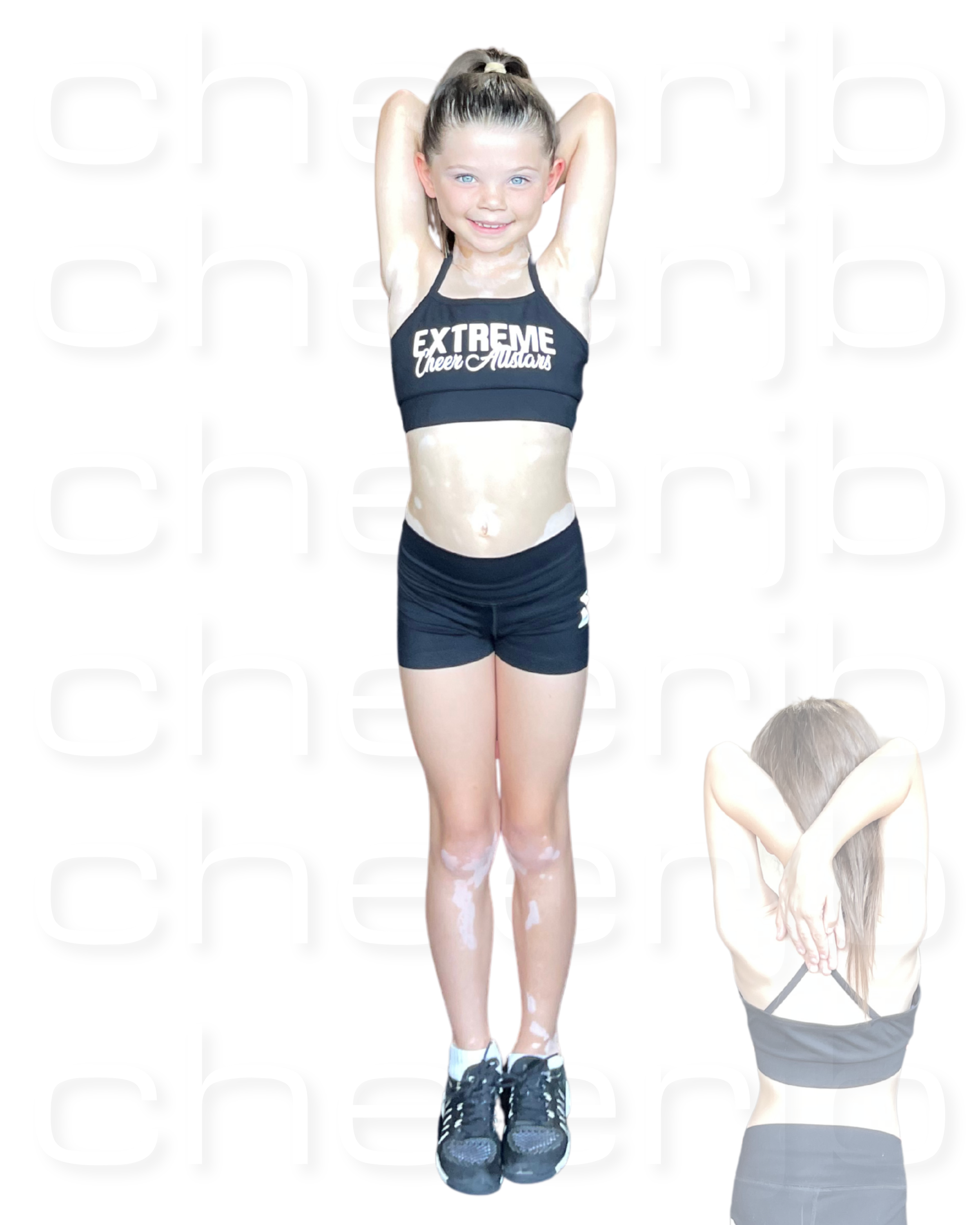Motions Mastery: Building Precision & Power
You've mastered the shapes—now it’s time to control the way you move. Motions are the next essential layer of your cheerleading foundation. When executed properly, motions not only create visual impact but also demonstrate strength, synchronization, and confidence.
Whether you're performing a routine or hitting a motion in a stunt sequence, every movement counts. These aren’t just arm placements—they’re a performance tool that directly affects your execution score and overall visual appeal.
Foundational Motions
Use these photos as a reference to study exact placements, angles, and posture. These are some of the most essential motions every cheerleader must master:
Each image demonstrates correct body alignment, arm angles, and hand placement. Study these details and mirror them during your drills for maximum accuracy.
Clean Position
Arms straight down by the sides
Hands in blades, fingers tight with no gaps, thumbs in
Hands slap the thighs on impact to make a noise
After impact, arms remain locked—no bounce or adjustment
Chest lifted, eyes up, shoulders back, chin neutral with a smile
Feet together, body tall, completely locked in
Clasp
Hands in blades, pressed tightly together in front of the face
Elbows in, level with shoulders
Keep the clasp tight and centered
Body tall: chest lifted, eyes up, chin neutral
Hands fit together seamlessly, fingers tight
Should create a strong, audible clap sound
Clap
Hands wrap together tightly in front of the face
Fingers engaged and pressed tight with no gaps
Elbows in and lifted
Chest and eyes up, chin neutral
Should create a sharp, loud clap
Palms fully connected—no space between hands
HIGH V
Arms extended upward in a wide “V” shape
Hands in tight fists, palms angled outward
Arms fully straight with energy through the fingertips
Shoulders relaxed, chest lifted, ribs tucked
Feet together, body tall
LOW V
Arms extended downward in a wide “V” shape
Hands in fists, knuckles facing forward, palms inward
Arms straight and strong with energy through the fingertips
Shoulders relaxed, chest lifted, ribs tucked
Feet together, body tall
Arms extended straight out to the sides at shoulder height
Hands in fists, palms facing the floor
Arms fully locked out, strong and level
Shoulders relaxed, chest lifted, ribs tucked
Feet together, body tall
T
BROKEN T
Same as T, but elbows bent at 90 degrees
Fists squeezed, palms facing the floor
Elbows strong and parallel to the floor
Shoulders relaxed, chest lifted, ribs tucked
Feet together, body tall
TOUCH DOWN
Arms extended straight up, creating two vertical lines toward the ceiling
Hands in fists, palms facing each other
Arms tight, fully locked out, biceps close to ears
Shoulders relaxed, ribs tucked in (not flared out)
Eyes looking up toward hands, head neutral
Feet together, body tall
TAG
(aka “Daggers”)
Elbows bent
Fists squeezed, palms inward, hands in blades
Biceps to ears
Chest lifted, eyes up, ribs tucked, feet together
Note: Sometimes referred to as “tags” because hands are positioned as if touching your tag/shoulder area
HUG
Arms rounded in front of the chest as if hugging a barrel
Elbows facing forward (not crossed) and slightly lifted
Hands reaching back toward shoulder blades
Chest up, eyes up, ribs tucked in, feet together
Should form a strong, controlled rounded frame
Here’s a recap of all the motions we just went over for your reference:
High V
Low V
T Position
Broken T
Touchdown
Daggers (Tags)
Hug Position
Clasp
Clap
Clean Position
Mastery doesn’t happen by accident—it comes from repetition with intention. Motions may look simple, but when done correctly, they set the standard for sharpness, discipline, and performance in cheerleading.
The Core Principles of Execution
Every athlete should master these fundamentals:
Consistency – Your motions should look identical every single time—same height, same angles, same energy.
Alignment – Correct placement is everything. Fists, wrists, and elbows must match the body’s line. No sagging, no flaring, no overextension.
Sharpness – Each motion should be hit with power and precision. No soft, bouncy, or lazy arms.
Energy – Motion isn’t just movement—it’s a statement. Bring energy, confidence, and presence into every count.
👉 Coach’s Note: Incorporate motion-placement drills into warm-ups and practice daily. Use counts, mirrors, and video review to build muscle memory and eliminate inconsistencies.
The Importance of Intention in Motions
Don’t just move—perform.
Motions become elite when athletes commit to every detail:
Engage your core and posture—not just your arms.
Lock in movements from start to finish.
Show strength not only in your body, but also in your face. Presence matters.
A motion without intention is just movement. A motion with intention is performance.
Tips for Perfecting Motions
✔️ Start in a Strong Clean Position
Arms at your sides, fists touching thighs—not behind or forward
Thumbs and fingers pressed together
Shoulders back, chest lifted, eyes forward
Create a crisp sound when cleaning together as a team
✔️ Emphasize Sharpness & Control
Hit motions with full body force and precision
No bouncing, no wobbling after hitting
Every count should be clean, still, and deliberate
✔️ Drill Placement & Precision Daily
Use mirrors to self-correct form
Practice slow-motion reps to build control before adding speed
Focus on synchronization—team unity creates visual power
Repetition = Results
Motions are a skill. And like any skill, they require consistent, focused training. The more you drill them with intention, the more natural, powerful, and performance-ready they become.
The difference between a good team and a great team is found in the details. Whether you’re an athlete sharpening your craft or a coach developing your team, motion mastery is a daily commitment.
Lock in. Get sharper. Get stronger. And level up.






